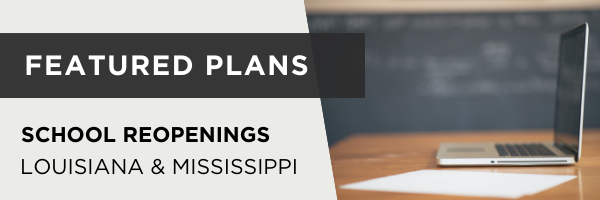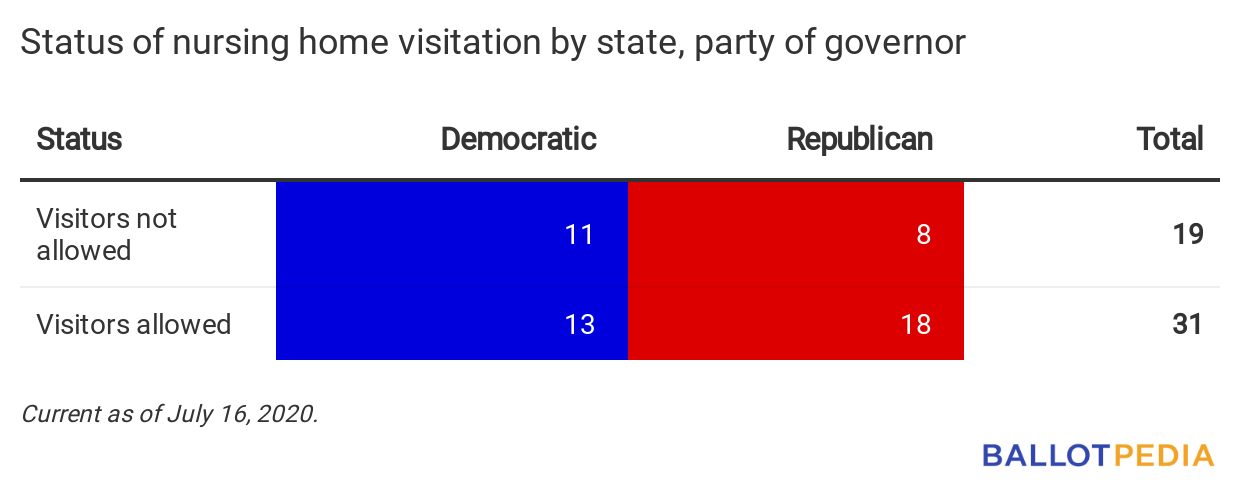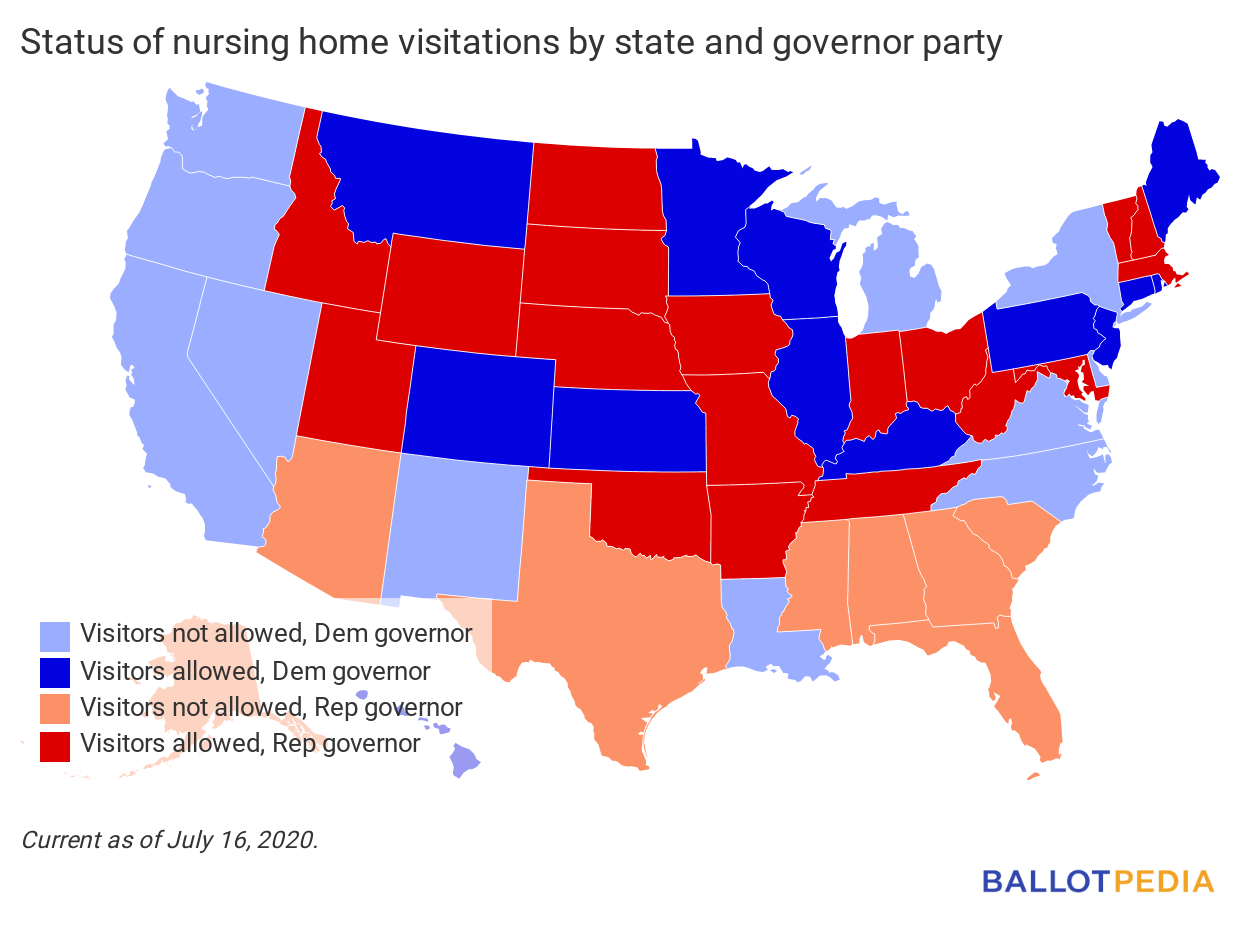Each day, we:
Want to know what happened yesterday? Click here. The next three daysWhat is changing in the next three days?
Since our last editionWhat is open in each state? For a continually updated article on reopening status in all 50 states, click here. For our last edition, click here.
Tracking industries: Nursing home visitsAll 50 states are reopening in some way. Here, we give the status of one industry or activity across the states. Today’s question: in which states may you visit someone in a nursing home? This does not include end-of-life or other emergency-related visits. Visits limited to family members only, or that are only allowed outdoors, are counted as “visitors allowed” in the chart and map below. We last looked at nursing home visitation in the July 8th edition of the newsletter. Since then, no new states have allowed or restricted visitation.
|
||||||||||||||||||||||||||||||||||||||||||||||||||||||||||||||||||||||||||||||||||||||||||

This is an in-depth summary of two state plans to reopen public K-12 schools for the 2020-2021 school year. Louisiana’s reopening planOn July 14, the Louisiana State Board of Elementary and Secondary Education unanimously approved Superintendent Cade Brumley’s proposed reopening guidelines. Brumley said that the guidelines were “minimum health and safety standards for every school in the state,” while allowing local districts to create their own specific plans. On March 13, Gov. John Bel Edwards (D) issued an executive order closing K-12 schools until April 13. On April 2, Edwards extended the closure through April 30. On April 13, Edwards made the closure effective for the remainder of the school year. Louisiana does not have a statewide date for public schools to reopen. According to EdWeek, public schools in Louisiana traditionally start the school year in early August, with the exact start date varying by district. ContextLouisiana has a divided government. The governor is a Democrat, and Republicans hold majorities in both chambers of the state legislature. The state has had a divided government since 2016. The following tables show public education statistics in Louisiana, including a rank comparing it to the other 49 states. Rank one is the highest number of each figure, rank 50 is the lowest. All data comes from the Common Core of Data provided by the National Center for Education Statistics.
DetailsDistrict reopening plans Under the guidelines, school districts are responsible for creating their own reopening plans in accordance with the guidelines. Brumley said each district must submit its plan to the state for approval, but did not say whether the plans had to be posted publicly. In-person, hybrid, and online learning Under the guidelines, school districts must decide whether students will learn face-to-face, remotely, or using a hybrid model. Individual students may be considered for remote or hybrid learning based on academic, social, emotional, familial, or medical needs. Mask requirements The guidelines state that adults and students in grades 3 through 12 must wear face coverings to the greatest extent possible. In-person health recommendations and requirements The guidelines place a limit on the number of individuals who can gather in a single room or outdoors at one time depending on the state’s reopening phase. During Phase One, 10 individuals can meet at one time. That limit expands to 25 during Phase Two and 50 during Phase Three. In a presentation on the guidelines, Brumley laid out how schools would respond to positive cases. If a school becomes aware of a presumptive case, the individual in question should not attend school until determined to be non-infectious by their doctor. School superintendents will be given authority, in consultation with the Office of Public Health, to determine whether a school must close if it becomes a coronavirus hotspot. Brumley said that one positive case did not mandate the closure of a classroom or school. Transportation and bussing requirements and restrictions As with meeting size limits, the guidelines determine bus capacity by the state’s reopening phase. During Phase One, buses may operate at 25% capacity. That capacity expands to 50% during Phase Two and 75% during Phase Three. Considerations For Reopening Mississippi SchoolsThe Mississippi Department of Education released school reopening guidance on June 8. The document contains recommendations for schools, school districts, and school boards, which have the final say on reopening decisions. Department of Education representative Jean Cook said the plan is “intended to be used as a resource and starting point for districts to consider local needs in collaboration with stakeholders.” On March 19, Gov. Tate Reeves (D) closed public schools until April 17. Reeves ended the public school year on April 21. Mississippi does not have a statewide date for schools to reopen. According to EdWeek, public schools in Mississippi traditionally start the academic year in early August, with the exact date varying by district. ContextMississippi is a Republican trifecta. The governor is a Republican, and Republicans hold majorities in both chambers of the state legislature. The state became a Republican trifecta in 2018. The following tables show public education statistics in Mississippi, including a rank comparing it to the other 49 states. Rank one is the highest number of each figure, rank 50 is the lowest. All data comes from the Common Core of Data provided by the National Center for Education Statistics.
DetailsDistrict reopening plans School districts are not required to develop individualized reopening plans or submit plans to the state. Districts and schools have full discretion in implementing the state’s recommendations. In-person, hybrid, and online learning The school reopening plan allows districts to choose between an in-person, hybrid, and fully virtual learning schedule at their discretion. The state recommends districts consider the circumstances of their students, noting that schedules that integrate online work and attendance could cause problems for students in rural areas without consistent internet access. Mask requirements Mississippi’s plan does not require students or teachers to wear masks, but schools still must comply with state and local health orders. Schools are encouraged to contact the Department of Health before reopening to obtain mask-wearing guidance. In-person health recommendations and requirements The plan suggests schools using an in-person schedule develop and implement the following general procedures:
Transportation and bussing requirements and restrictions The plan suggests considering the availability of bus capacity before committing to a specific schedule type (such as hybrid or fully in-person). For schools using buses for fully in-person and hybrid schedules, the plan recommends the following:
Additional activityIn this section, we feature examples of activities by other federal, state, and local governments and influencers relevant to recovering from the pandemic. Prince George’s County Public Schools in Maryland announced it will remain fully remote through at least January. The district is the second-largest in Maryland and one of the 25 largest in the country. |
||||||||||||||||||||||||||||||||||||||||||||||||||||||||||||||||||||||||||||||||||||||||||
Documenting America’s Path to Recovery: July 16, 2020
By



